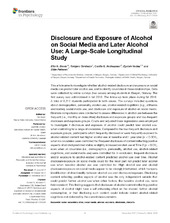| dc.description.abstract | This article aims to investigate whether alcohol-related disclosure and exposure on social media can predict later alcohol use, and to identify covariates in these relationships. Data were collected by online surveys (two waves) among students in Bergen, Norway. The first survey was administered in fall 2015. The follow-up took place during fall 2016. A total of 5,217 students participated in both waves. The surveys included questions about demographics, personality, alcohol use, alcohol-related cognitions (e.g., attitudes and norms), social media use, and disclosure and exposure of alcohol on social media. Bivariate comparisons were conducted to assess differences in alcohol use between the frequent (i.e., monthly or more often) disclosure and exposure groups and low-frequent disclosure and exposure groups. Crude and adjusted linear regressions were employed to investigate if disclosure and exposure of alcohol could predict later alcohol use, when controlling for a range of covariates. Compared to the low-frequent disclosure and exposure groups, participants which frequently disclosed or were frequently exposed to alcohol-related content had higher alcohol use at baseline and 1 year later (p < 0.001), when no covariates were controlled for. Frequent disclosure of content reflecting positive aspects of alcohol predicted stable or slightly increased alcohol use at Time 2 (p < 0.01), even when all covariates (i.e., demographics, personality, alcohol use, alcohol-related cognitions, and social media use) were controlled for. In conclusion, frequent disclosure and/or exposure to alcohol-related content predicted alcohol use over time. Alcohol disclosure/exposure on social media could for the most part not predict later alcohol use when baseline alcohol use was controlled for. High alcohol use and alcohol disclosure/exposure on social media appear to be strongly intertwined, which hampers identification of directionality between alcohol use and disclosure/exposure. Disclosing content reflecting positive aspects of alcohol was the only independent variable that could predict further alcohol use when other factors, like baseline alcohol use, were held constant. This finding suggests that disclosure of alcohol content reflecting positive aspects of alcohol might have a self-enhancing effect on the sharers' further alcohol consumption, or that disclosing such content could indicate lenient alcohol-related cognitions not detected by the current measurements. | en_US |

